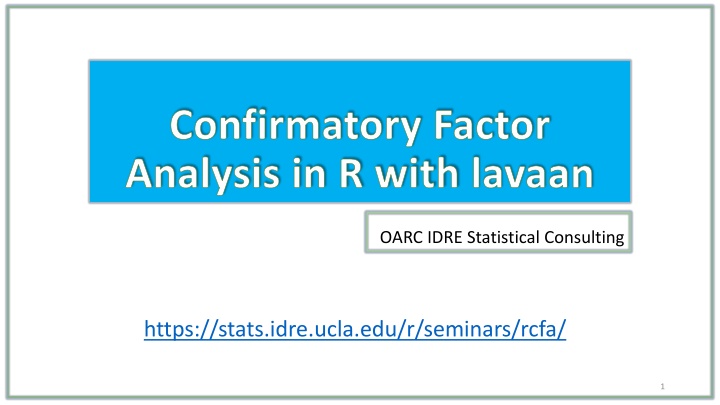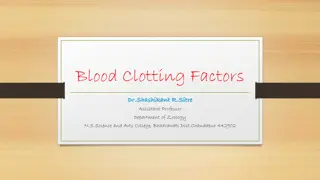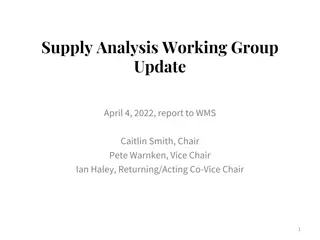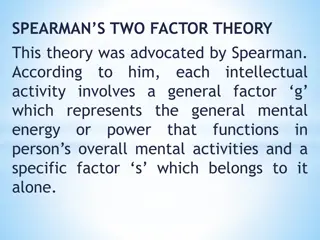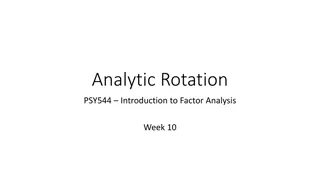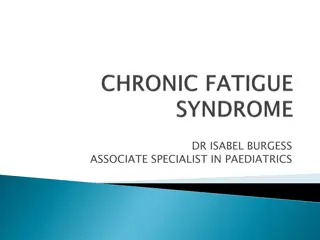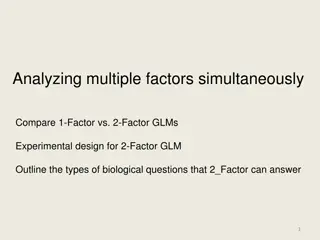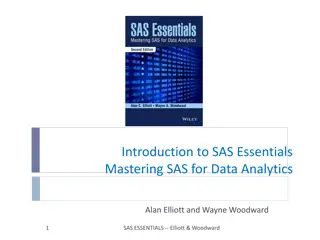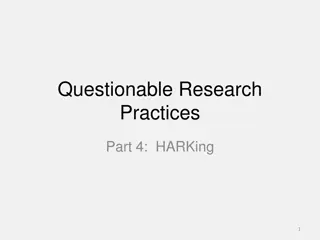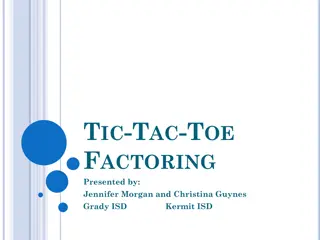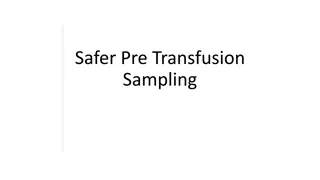Confirmatory Factor Analysis in R with lavaan
In this guide on Confirmatory Factor Analysis (CFA) using lavaan in R, you will learn the basics with a motivating example, model fit statistics, and practical implementation steps. Understand the variance-covariance matrix, path diagram, model-implied covariance matrix, and more. Explore one-factor CFA, model fit indices like CFI and RMSEA, two-factor CFA, and correlation analysis. Dive into correlation tables, data preparation, and running CFA models with lavaan. Get ready to enhance your statistical analysis skills with practical exercises and an introduction to Structural Equation Modeling (SEM).
Download Presentation

Please find below an Image/Link to download the presentation.
The content on the website is provided AS IS for your information and personal use only. It may not be sold, licensed, or shared on other websites without obtaining consent from the author.If you encounter any issues during the download, it is possible that the publisher has removed the file from their server.
You are allowed to download the files provided on this website for personal or commercial use, subject to the condition that they are used lawfully. All files are the property of their respective owners.
The content on the website is provided AS IS for your information and personal use only. It may not be sold, licensed, or shared on other websites without obtaining consent from the author.
E N D
Presentation Transcript
Confirmatory Factor Analysis in R with lavaan OARC IDRE Statistical Consulting https://stats.idre.ucla.edu/r/seminars/rcfa/ 1
Outline 1 Introduction Motivating example: The SAQ Variance-covariance matrix Factor analysis model Model-implied covariance matrix Path Diagram One Factor CFA Known values, parameters, and degrees of freedom Three-item (one) factor analysis Identification of a three-item one factor CFA Running a one-factor CFA in lavaan 2
Outline 2 Model Fit Statistics Model chi-square Approximate fit indices CFI (Confirmatory Factor Index) TLI (Tucker Lewis Index) RMSEA Two Factor Confirmatory Factor Analysis Correlated factors Intermission Exercises 3
Introduction Motivating example: The SAQ Variance-covariance matrix Factor analysis model Model-implied covariance matrix Path Diagram 4
Overview EFA CFA Exploratory Factor Analysis CFA SEM Introduction to SEM 5
SAQ N = 2571 1.Statistics makes me cry 2.My friends will think I m stupid for not being able to cope with SPSS 3.Standard deviations excite me 4.I dream that Pearson is attacking me with correlation coefficients 5.I don t understand statistics 6.I have little experience with computers 7.All computers hate me 8.I have never been good at mathematics 1 2 3 4 5 Strongly Disagree Disagree Neither Agree or Disagree Agree Strongly Agree 6
Preparations install.packages("foreign", dependencies=TRUE) install.packages("lavaan", dependencies=TRUE) library(foreign) library(lavaan) dat <- read.spss("https://stats.idre.ucla.edu/wp- content/uploads/2018/05/SAQ.sav", to.data.frame=TRUE, use.value.labels = FALSE) 7
Correlation Table > round(cor(dat[,1:8]),2) q01 q02 q03 q04 q05 q06 q07 q08 q01 1.00 -0.10 -0.34 0.44 0.40 0.22 0.31 0.33 q02 -0.10 1.00 0.32 -0.11 -0.12 -0.07 -0.16 -0.05 q03 -0.34 0.32 1.00 -0.38 -0.31 -0.23 -0.38 -0.26 q04 0.44 -0.11 -0.38 1.00 0.40 0.28 0.41 0.35 q05 0.40 -0.12 -0.31 0.40 1.00 0.26 0.34 0.27 q06 0.22 -0.07 -0.23 0.28 0.26 1.00 0.51 0.22 q07 0.31 -0.16 -0.38 0.41 0.34 0.51 1.00 0.30 q08 0.33 -0.05 -0.26 0.35 0.27 0.22 0.30 1.00 8
Model Implied Covariance Matrix versus 10
Path Diagram 11
One Factor CFA Known values, parameters, and degrees of freedom Three-item (one) factor analysis Identification of a three-item one factor CFA Running a one-factor CFA in lavaan 13
Sample Covariance Matrix versus versus > round(cov(dat[,3:5]),2) q03 q04 q05 q03 1.16 -0.39 -0.32 q04 -0.39 0.90 0.37 q05 -0.32 0.37 0.90 15
Degrees of freedom known values: total number of parameters For three items Highlight the unique parameters. Count 10. 16
Fixed vs. free parameters fixed parameters pre-determined to have a specific value free parameters 17
Degrees of freedom Calculate the degrees of freedom for our model. Should be 6. df negative, known < free (under-identified, cannot run model) df = 0, known = free (just identified or saturated, no model fit) df positive, known > free (over-identified, model fit can be assessed) 18
Poll 1 1. There is 1 degree of freedom in my model, which means that my model is over-identified 2. I have three items in my study. The number of known values is 6. 3. I have three items in my study. There are 6 unique parameters and no fixed parameters. My model is just-identified. ( Single Choice) 19
Three Item CFA Intercepts sometimes not estimated 20
Identification of Three-Item marker method fixes the first loading of each factor to 1 variance standardization method fixes the variance of each factor to 1 but freely estimates all loadings. 21
Lavaan syntax ~ predict regression =~ indicator factor analysis ~~ covariance ~1 intercept 1* fixes parameter NA* frees parameter useful to override default marker method a* labels the parameter a , model constraints 22
Marker Method in lavaan #one factor three items, default marker method m1a <- ' f =~ q03 + q04 + q05' onefac3items_a <- cfa(m1a, data=dat) summary(onefac3items_a) 23
Marker Method Output Latent Variables: Estimate Std.Err z-value P(>|z|) f =~ q03 1.000 q04 -1.139 0.073 -15.652 0.000 q05 -0.945 0.056 -16.840 0.000 Variances: Estimate Std.Err z-value P(>|z|) .q03 0.815 0.031 26.484 0.000 .q04 0.458 0.030 15.359 0.000 SAQ (Likert 1-5) 3. Standard deviations excite me 4. I dream that Pearson is attacking me with correlation coefficients 5. I don t understand statistics .q05 0.626 0.025 24.599 0.000 f 0.340 0.031 11.034 0.000 For a one unit (in Item 3) increase in SPSS-Anxiety, Item 4 goes down by 1.13 points. Variance of the factor is scaled by units of Item 3. 24
Variance Std Method #one factor three items, variance std m1b <- ' f =~ NA*q03 + q04 + q05 f ~~ 1*f ' onefac3items_b <- cfa(m1b, data=dat) summary(onefac3items_b) 25
Variance Std Output Latent Variables: Estimate Std.Err z-value P(>|z|) f =~ q03 0.583 0.026 22.067 0.000 q04 -0.665 0.026 -25.605 0.000 q05 -0.551 0.024 -22.800 0.000 Variances: Estimate Std.Err z-value P(>|z|) f 1.000 .q03 0.815 0.031 26.484 0.000 SAQ (Likert 1-5) 3. Standard deviations excite me 4. I dream that Pearson is attacking me with correlation coefficients 5. I don t understand statistics .q04 0.458 0.030 15.359 0.000 .q05 0.626 0.025 24.599 0.000 For one standard deviation increase in SPSS-Anxiety, Item 4 goes down by 0.665 points. Variance of the factor is scaled to 1. 26
Automatic Standardization in lavaan For one standard deviation increase in SPSS-Anxiety, Item 4 goes down by 0.701 standard deviation units . Variance of the factor is scaled to 1. > summary(onefac3items_a,standardized=TRUE) Latent Variables: Estimate Std.Err z-value P(>|z|) Std.lvStd.all f =~ q03 1.000 0.583 0.543 q04 -1.139 0.073 -15.652 0.000 -0.665 -0.701 q05 -0.945 0.056 -16.840 0.000 -0.551 -0.572 Variances: Estimate Std.Err z-value P(>|z|) Std.lv Std.all .q03 0.815 0.031 26.484 0.000 0.815 0.705 .q04 0.458 0.030 15.359 0.000 0.458 0.509 .q05 0.626 0.025 24.599 0.000 0.626 0.673 f 0.340 0.031 11.034 0.000 1.000 1.000 27
Full Model f =~ q01 0.485 0.017 28.942 0.000 0.485 0.586 q02 -0.198 0.019 -10.633 0.000 -0.198 -0.233 q03 -0.612 0.022 -27.989 0.000 -0.612 -0.570 q04 0.632 0.019 33.810 0.000 0.632 0.667 q05 0.554 0.020 28.259 0.000 0.554 0.574 q06 0.554 0.023 23.742 0.000 0.554 0.494 q07 0.716 0.022 32.761 0.000 0.716 0.650 q08 0.424 0.018 23.292 0.000 0.424 0.486 28
Model Fit Statistics Model chi-square Approximate fit indices CFI / TLI / RMSEA 29
Hypothesis accept-support test versus reject-support test versus versus residual covariance matrix 30
Poll 2 1. T/F The residual covariance matrix is defined as the population covariance matrix minus the model implied covariance matrix. It will never approach zero but can approximate zero. 2. T/F The goal of SEM is the recreate the population covariance matrix using model parameters. Therefore, we want to REJECT the null hypothesis. 3. T/F The larger the sample size the more likely we will reject the null hypothesis in SEM. 31
Model Chi-square #Three Item One-Factor CFA (Just Identified) Number of free parameters 6 Model Test User Model: Test statistic 0.000 Degrees of freedom 0 #Eight Item One-Factor CFA (Over-identified) Number of free parameters 16 Model Test User Model: Test statistic 554.191 Degrees of freedom 20 P-value (Chi-square) 0.000 But we often reject the null hypothesis for large samples! 32
Measures of Fit in CFA Exact Fit 33
Baseline Model How many free parameters? Count 8. How many degrees of freedom? Count 28. 8(9)/2 8. Worst model. Compare with saturated model. 34
Baseline 35
RMSEA 36
Criteria for fit 1.Model chi-square maximum likelihood (Model Test User Model) 2.CFI Confirmatory Factor Index values can range between 0 and 1 (> 0.90, conservatively 0.95 indicate good fit) 3.TLI Tucker Lewis Index between 0 and 1 (> 1 1) with values greater than 0.90 indicating good fit. CFI > TLI. 4.RMSEA is the root mean square error of approximation p-value of close fit, ?0: ????? 0.05. reject the model, not a close-fitting model look at the confidence interval 37
Fit Statistics 1 summary(onefac8items_a, fit.measures=TRUE, standardized=TRUE) lavaan 0.6-5 ended normally after 15 iterations Number of free parameters 16 Number of observations 2571 Model Test User Model: Test statistic 554.191 Degrees of freedom 20 P-value (Chi-square) 0.000 Model Test Baseline Model: Test statistic 4164.572 Degrees of freedom 28 P-value 0.000 38
Fit Statistics 2 User Model versus Baseline Model: Comparative Fit Index (CFI) 0.871 Tucker-Lewis Index (TLI) 0.819 Root Mean Square Error of Approximation: RMSEA 0.102 90 Percent confidence interval - lower 0.095 90 Percent confidence interval - upper 0.109 P-value RMSEA <= 0.05 0.000 Standardized Root Mean Square Residual: SRMR 0.055 39
Two Factor Confirmatory Factor Analysis Correlated factors Uncorrelated factors 40
Path Diagram What standardization method are we using here? 41
Correlated Factors #correlated two factor solution, marker method m4b <- 'f1 =~ q01+ q03 + q04 + q05 + q08 f2 =~ q06 + q07' twofac7items_b <- cfa(m4b, data=dat,std.lv=TRUE) summary(twofac7items_b,fit.measures=TRUE,standardized=TRUE) 42
Output 1 Latent Variables: Estimate Std.Err z-value P(>|z|) Std.lv Std.all f1 =~ q01 0.513 0.017 30.460 0.000 0.513 0.619 q03 -0.599 0.022 -26.941 0.000 -0.599 -0.557 q04 0.658 0.019 34.876 0.000 0.658 0.694 q05 0.567 0.020 28.676 0.000 0.567 0.588 q08 0.435 0.018 23.701 0.000 0.435 0.498 f2 =~ q06 0.669 0.025 27.001 0.000 0.669 0.596 q07 0.949 0.027 35.310 0.000 0.949 0.861 43
Output 2 Covariances: Estimate Std.Err z-value P(>|z|) Std.lv Std.all f1 ~~ f2 0.676 0.020 33.023 0.000 0.676 0.676 Variances: Estimate Std.Err z-value P(>|z|) Std.lv Std.all .q01 0.423 0.014 29.157 0.000 0.423 0.617 .q03 0.796 0.026 31.025 0.000 0.796 0.689 .q04 0.466 0.018 25.824 0.000 0.466 0.518 .q05 0.608 0.020 30.173 0.000 0.608 0.654 .q08 0.572 0.018 32.332 0.000 0.572 0.752 .q06 0.811 0.030 27.187 0.000 0.811 0.644 .q07 0.314 0.040 7.815 0.000 0.314 0.258 f1 1.000 1.000 1.000 f2 1.000 1.000 1.000 44
Uncorrelated Factors #uncorrelated two factor solution m4a <- 'f1 =~ q01+ q03 + q04 + q05 + q08 f2 =~ q06 + q07 f1 ~~ 0*f2 ' 45
Output Warning message: In lav_model_vcov(lavmodel = lavmodel, lavsamplestats = lavsamplestats, : lavaan WARNING: Could not compute standard errors! The information matrix could not be inverted. This may be a symptom that the model is not identified. 46
Poll 3 1. T/F By default, lavaan correlates the factors in a two-factor CFA. 2. T/F Either marker or variance standardization methods can be used for two factor CFA 3. T/F Turning off the factor covariance is an assumption; it doesn t mean that there actually is no factor covariance in my sample. 47
Intermission This concludes the lecture portion of the seminar. We will go over three exercises in the following section. 48
Exercise1 1. Fit a CFA with all 8 items in the SAQ A) marker method B) variance standardization method C) all standardized 2. Interpret the loadings 3. Assess the fit of the model using Chi-square, CFI/TLI, and RMSEA. If your fit fails the standard criteria, name some reasons for the poor fit. 49
Exercise 2 Fit the first 4 items to Factor 1 and second 4 items to Factor 2 A) Choose any standardization method B) Remove the items with the lowest loadings. How does the fit compare? C) Now fit an uncorrelated two factor model Compare the fit of the uncorrelated model to the correlated model Which one do you choose? 50
